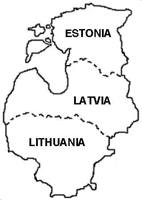
|
The Society of Folk Dance Historians (SFDH) Baltic States
[
Home |
About |
Encyclopedia | CLICK IMAGE TO ENLARGE |

|
BACKGROUND
Information: Three countries
Languages: Latvian, Lithuanian, and Estonian (a Finnic language)
Religions: Predominantly Lutheran
The Baltic states, also known as the Baltic countries, Baltic republics, Baltic nations, or simply the Baltics, is a geopolitical term used for grouping the three sovereign states in Northern Europe on the eastern coast of the Baltic Sea: Estonia, Latvia, and Lithuania.
After World War I the three new sovereign states that emerged on the east coast of the Baltic sea became known as "The Baltic States." Each of the three countries has declared itself to be the restoration of the sovereign nation that had existed from 1918 to 1940, emphasizing their contention that Soviet domination over the Baltic nations during the Cold War period had been an illegal occupation and annexation.
Estonians are Finnic people, together with the neighboring Finns. The Latvians and Lithuanians, linguistically and culturally related to each other, are Baltic and Indo-European people. The peoples comprising the Baltic states have together inhabited the eastern coast of the Baltic Sea for millennia, although not always peacefully in ancient times, over which period their populations, Estonian, Latvian, and Lithuanian have remained remarkably stable within the approximate territorial boundaries of the current Baltic states. While separate peoples with their own customs and traditions, historical factors have introduced cultural commonalities across and differences within them.
DOCUMENTS
- Estonia, a country
- Latvia, a country
- Lithuania, a country
- Lithuanian Folk Dances, an article.
This page © 2018 by Ron Houston.
Please do not copy any part of this page without including this copyright notice.
Please do not copy small portions out of context.
Please do not copy large portions without permission from Ron Houston.